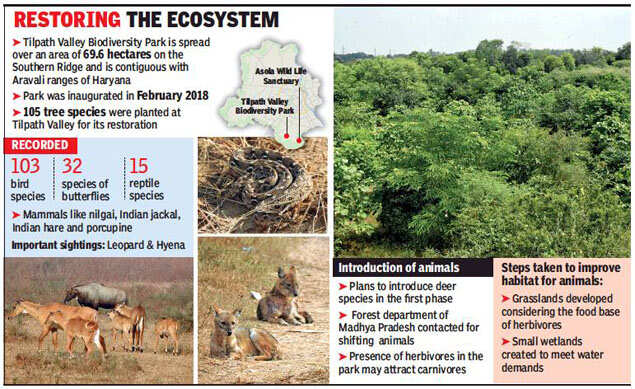 |
| Tilpath Valley Biodiversity Park facts |
In India, the National Capital Territory of Delhi saw the inauguration of Tilpath Valley Biodiversity Park on February 3 2018. The area is comprised of grasslands and hilly terrain with over 105 species of trees and shrubs. In addition, 103 birds, 32 butterflies, 15 reptiles and amphibians, and 8 mammals call the area home. Now recently, plans are underway to repopulate the park with herbivore species. According to park officials, they are in collaboration with the Madhya Pradesh Forest Department to translocate the animals. They are also hopeful that herbivores would migrate from the neighboring Aravalli mountain range in Haryana and Asola Bhatti Wildlife Sanctuary. The purpose of introducing herbivores would help diversify the park ecologically. C.R Babu, professor emeritus and head of Delhi University's Center for Environmental Management of Degraded Ecosystem, stated that the first phase of herbivore introduction focuses on chital (spotted deer) and chinkara (Indian gazelle). Then, the diversification process may be directed at bringing in others like hog deer which will require a specialized grassland. Park officials pointed out that the only carnivores confirmed in the park are civets. However, in the past, local villagers have reported sighting leopards and hyenas in the area. But these were thought to have strayed into the vicinity briefly from the Aravallis. The introduction of herbivores in Tilpath Valley would attract leopards and hyenas thus further diversifying the park.
 |
Forest cover in Tilpath Valley Biodiversity Park
|
I really admire the efforts forest officials are putting to diversify Tilpath Valley. Doing so can further benefit the park's ecosystem. Currently, the only herbivorous species documented in the park is the
nilgai (blue bull). The largest antelope in India, its sheer size makes it an ideal prey for
lions and
tigers. Don't get me wrong; leopards also prey on nilgai but they prefer medium-sized prey like deer. Hyenas, on the other hand, work either alone or in pairs compared to their pack-oriented African counterparts. So taking on a full-grown nilgai would not be worth a risk. This is why I hope the habitat of Tilpath Valley will attract medium-sized herbivores via migration and in turn bring leopards and hyenas into the area. I would also suggest that the nilgai population should be closely monitored. In areas lacking presence of powerful predators, they could negatively impact the ecological balance by multiplying. For this reason, I believe it is important to possibly consider bringing tigers into Tilpath Valley to keep the nilgai and other herbivore populations in check. But as of right now, the park needs more herbivores to benefit the carnivore populations.


No comments:
Post a Comment